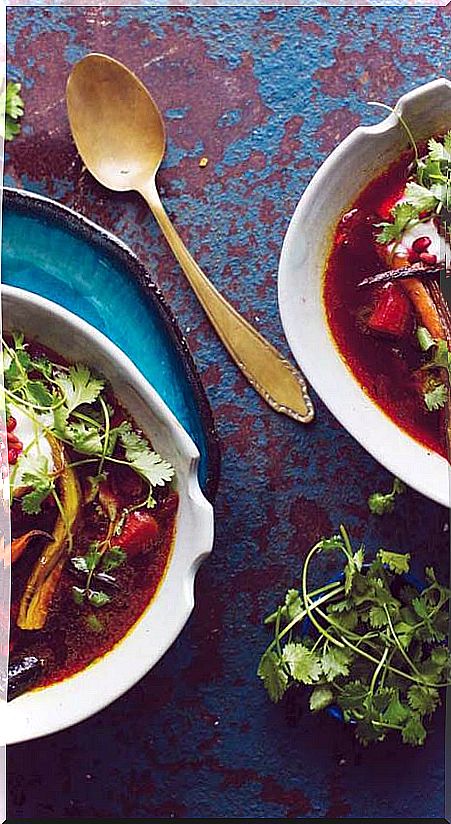How To Have A Good Homemade Vegetable Broth Always Ready
A well-made broth is the key to success not only for soups, but also for stews or legumes. I propose four recipes that you can freeze and use whenever you prefer.

Broths are the basis of many dishes. They provide flavor and color without becoming too thick or monopolizing the entire spectrum of flavors of our preparations.
Sometimes, it is much better to use a broth than just water (think for example in soups and stews), both for the flavor and for the nutrients that we can add.
The commercial broths, whether in powder, tablet or bricks, are very useful in the kitchen, especially if you do not have time to get to make a good broth, though its composition is rather Malucha: too much salt, fat sleazy and an anecdotal amount of vegetables.
Some mixtures of freeze-dried vegetables and herbs (without anything else, neither salt nor oils) do serve us very well to make broths, as well as dehydrated vegetables for soups (julienne soup for example).
If you want to always have homemade broth and not depend on these options, it is best to prepare a good amount when we have a little free time, refrigerate and freeze.
4 vegetable broths ideal to have in the freezer
The broths freeze perfectly, it is almost all water, so we can freeze them in small or medium containers, to use only what we need.
Defrosting them is very simple: either you leave them in the fridge the night before or you put the frozen block directly in the saucepan, over low heat, covered, until it is completely dissolved.
As we want it to spread, it is best to make concentrated broths. Thus, instead of freezing 10 liters, we freeze 4 or 5 and add water as needed.
Vegetable base broth
Ingredients:
- 1 onion (yellow or white, whatever you want)
- 3 carrots
- 1 medium leek
- 1 stick of celery
- 1 clove garlic
- salt (a half teaspoon per liter of water)
preparation:
- Bring 2.5 liters of water to a boil in a pot over high heat.
- Wash the vegetables and cut them into medium-small pieces. The garlic clove can be cut only in half or in 4 parts.
- Add all the vegetables and salt to the pot, put it on a low heat, covered, and let it boil for 1 hour.
- The broth will be quite concentrated in flavor, so you can freeze it in ice buckets or small-medium containers.
- If you prefer, you can reduce it even more by putting it on medium heat, uncovered, an extra 15-20 minutes.
- Remember that later, when using it, you will have to add water (more or less as if you were using commercial powdered broth).
With this vegetable broth you can make any dish that requires an extra flavor and sauce. For example vegetable soups, legumes, stews, stews, stews, etc.
Autumn Vegetable Broth
Ingredients:
- 500 g of pumpkin (butternut for example, which is not very sweet)
- 1 yellow onion
- 1 parsnip
- 2 turnips
- medium medium cabbage
- salt (a half teaspoon per liter of water)
preparation:
- Bring 2.5 liters of water to a boil in a large pot over high heat. It is important that the pot is large because the cut cabbage will have a lot of volume at the beginning and it may come out if we use a casserole with the right size.
- Wash the vegetables and cut them into medium small cubes. Cut the cabbage into thin strips.
- Add it all to the pot along with the salt and mash it well so that the cabbage enters.
- Boil it all together for 1 hour over medium-low heat, half covered.
- Strain the broth and store it in the fridge or frozen.
- If you want to reduce it further, you can leave it an extra 15-20 minutes over medium heat, uncovered.
Take advantage of this broth for your soups and stews in the cold season, especially legumes.
Broth with aromatic herbs
Ingredients:
- 1 medium leek
- 2 carrots
- 6-8 portobello mushrooms (or white)
- 2 bay leaves
- 1 sprig of rosemary
- 1 small bunch of parsley (about 50g fresh parsley)
- some mint leaves (4 or 5)
- 1 teaspoon coriander seeds
- 1 teaspoon of salt, approximately
preparation:
- Bring 2.5 liters of water to boil in a pot.
- Wash the vegetables and mushrooms and cut them into medium pieces.
- Add everything to the pot and when it comes to a strong boil, put it on a low heat, half covered, for 50 minutes.
- Store the broth in the fridge or freeze it.
- To reduce it, first remove the rosemary and mint, because they tend to be very strong, and boil it over medium heat, uncovered, 20-25 more minutes.
This broth will come in handy for soupy rice dishes, pasta sauces and sauces for seitan roasts, tofu, etc.
Dashi with oriental flavors
It is the name of Japanese broths. The most used usually has flaked bonito, so it is not vegan, but other dashi that do not contain ingredients of animal origin are also made and consumed.
The kombu dashi is kombu seaweed broth. It’s super simple: you just have to wash a piece of kombu seaweed (about 30 grams per liter of water) and boil over medium-low heat, removing the foam that forms on the surface (if any). It will take about 20 minutes to boil. When it comes to a strong boil, remove the kombu pieces and strain the broth before storing.
The shiitake dashi is also very easy to prepare and has a stronger flavor than kombu. For this he uses dehydrated shiitake mushrooms, which have much more flavor than fresh ones. Soak 3 or 4 dried shiitake per liter of water, preferably warm. Let them rest for at least 4 hours (if you can, leave them overnight), drain them well and save the broth.
Of course, you can also make dashi with both kombu seaweed and shiitake broth. They are excellent bases for all kinds of Japanese soups.









